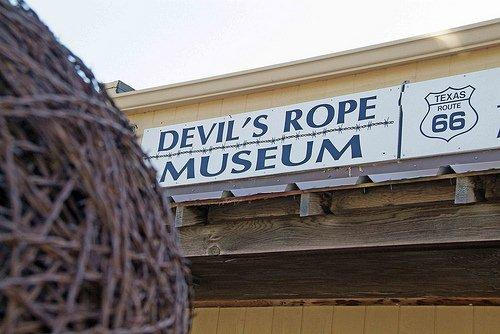|
During
the early 1880s, Jacob and Warren M. Brinkerhoff invented and patented
13 varieties of a galvanized ribbon barbed wire with saber-type points.
Most Panhandle historians
agree this Brinkerhoff ribbon was nds.
Being a wire collector, I purchased several rolls of Brinkerhoff for
various reasons. The largest group of rolls came from an old-time
farmer in the Channing
area whose grandfather had rolled up the wire after purchasing land
from the XIT Land Company when they began offering their best farming
acreage for sale.
A recent construction project here on the Trew Ranch involved fencing
a few acres surrounding a new fishing and camping site. For nostalgic
reasons, I had the inspiration to build a 100-yard stretch of the
new fence using the old XIT ribbon wire. It just might be the only
"new " section of fence in the Panhandle
using the old Brinkerhoff wire now older than 100 years.
This turned out to be a new learning experience for me in spite of
a lifetime of working on barbed-wire
fences. Before I finished this section of fence, I determined
the Brinkerhoff wire was alive and working diligently to thwart every
move I made. After I finished the section of fence, I am convinced
history should be revised and rewritten.
For example, history states, "Injury to both humans and livestock
by vicious barbed wire suggest this invention is the work of the devil.
Hence the nickname given to early barbed wire was the Devil's Rope."
After working with Brinkerhoff ribbon wire, I believe the quote was
misstated. The statement should read, "This #*+@**##XX blankety-blank
abomination is the revenge of progress and any landowner who buys
it should go straight to the devil."
I found it is next to impossible to roll or unroll Brinkerhoff as
every saber tooth entangles with the next barb along every foot of
length. The points are sharp and the wire stiff enough to twist and
turn striking like a rattlesnake puncturing the thickest leather gloves.
Since the ribbon is flat and the tensile so strong it makes for difficult
splicing. If bent sharply, the wire breaks. No matter the design of
the cutting tool, the flat ribbon is hard to cut.the most famous barbed
wire in Panhandle
history as the XIT
Ranch used some 6,000 miles of the invention to fence their vast
grassland. |
 |
Events in Panhandle
history such as the Old
Tascosa Cowboy Strike is now easier to understand as they were
probably being forced to install Brinkerhoff on new ranch fencing.
The rules of conduct adopted by the XIT
Ranch preventing foul language, fights and the consumption of
alcoholic spirits were probably the result of listening to the bunk
house conversations after a hard day's work installing Brinkerhoff
ribbon fencing.
There is little doubt the extremely high consumption of liquor at
Old Tascosa
and along the Cimarron Strip saloons during this period could be attributed
to fencing crews working with Brinkerhoff wire. I hereby respectfully
suggest that history be revised and rewritten with the name of the
Devil's Rope being changed to "#*+@**##XX blankety-blank Brinkerhoff
Ribbon wire."
© Delbert Trew
"It's All Trew" December
30, 2008 Column |
|
|
